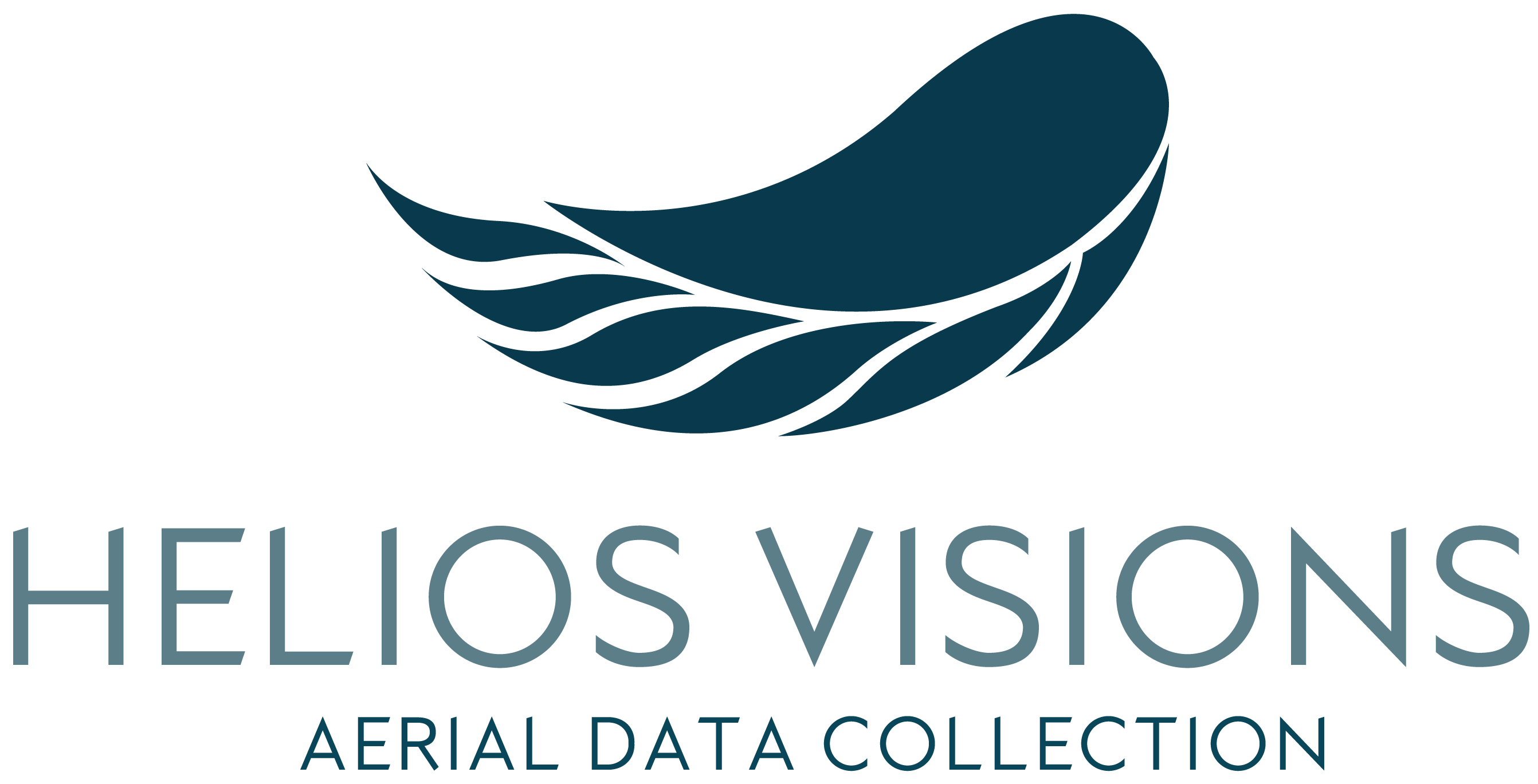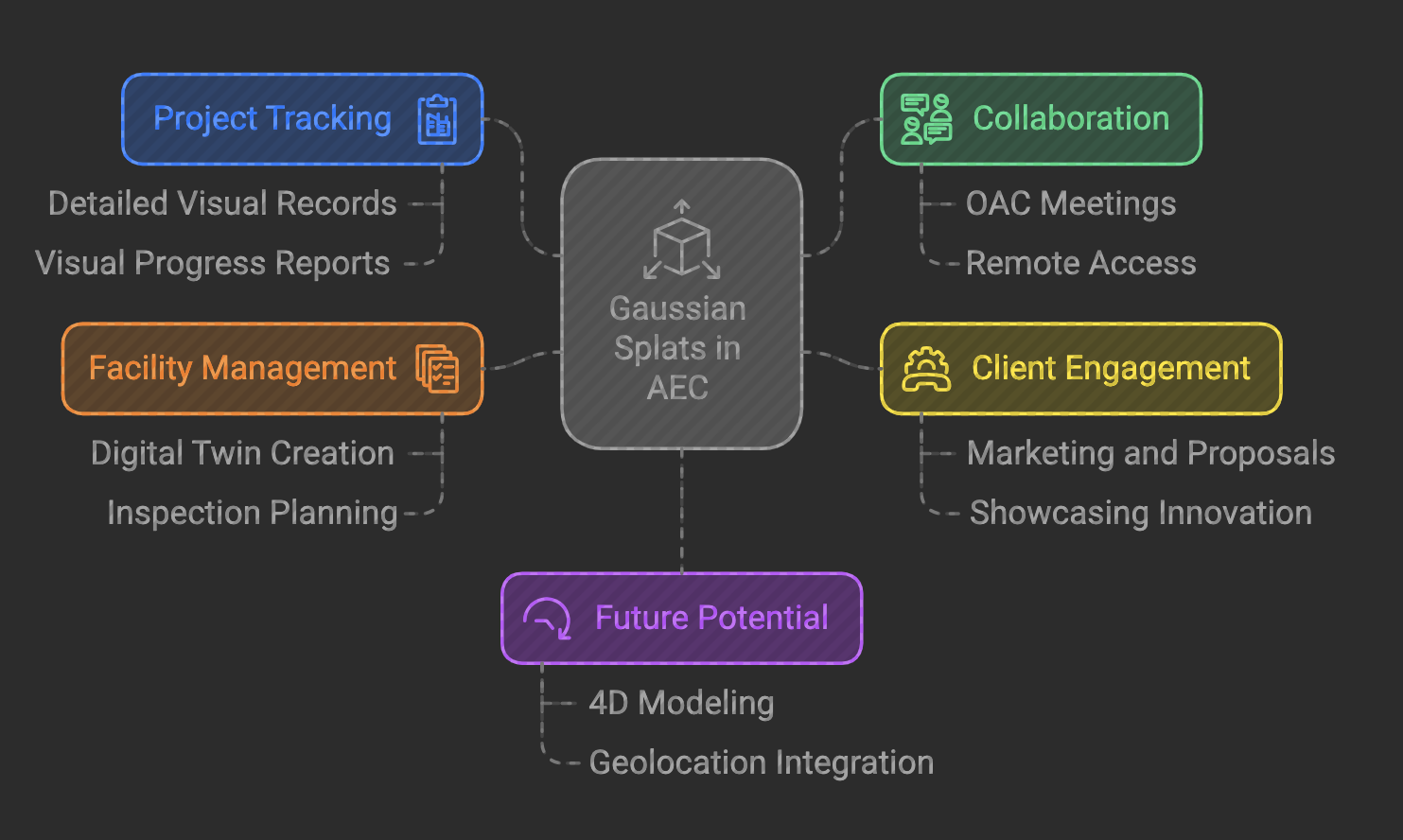The Architecture, Engineering, and Construction (AEC) industry has always sought advancements in visualization technology to enhance project accuracy, reduce errors, and improve communication among stakeholders.
Gaussian Splats, a recent development in 3D visualization technology, has emerged as a powerful tool in this quest, offering unparalleled detail and precision. Leveraging drone footage, Gaussian Splats create intricate, immersive 3D models. They excel in capturing reflective surfaces, such as glass and metal, where traditional photogrammetry often struggles.
Early AEC pioneers adopting this technology are now combining it with geolocation, measurement, and 4D tracking capabilities, addressing previous limitations and opening new opportunities for AEC firms.
This article explores how Gaussian Splat technology works, its advantages over photogrammetry, and how AEC firms can leverage it throughout the project lifecycle.
What Are Gaussian Splats and How Do They Work?
Gaussian Splats represent a different approach to 3D modeling than photogrammetry. Instead of creating a mesh from a point cloud, Gaussian Splat technology reconstructs surfaces using a dense collection of small, overlapping spheres, or “splats.” Each splat carries color, transparency, and other data that, when combined, form a detailed and continuous 3D model.
The unique advantage of Gaussian Splats is their ability to render highly reflective or transparent surfaces—such as glass buildings, polished metal, and even small, intricate details like power lines or fine piping—with remarkable fidelity. These surfaces typically present challenges for photogrammetry, as reflections or see-through properties can distort the data. Gaussian Splats bypass these issues by creating a continuous, smooth surface that accurately represents such materials.
Advantages of Gaussian Splats Over Traditional Photogrammetry
While photogrammetry has long been the go-to method for 3D visualization in AEC, it comes with limitations, particularly with reflective and transparent materials. Gaussian Splats, on the other hand, excel in these scenarios. Here’s a closer look at the key benefits:
- Superior Detail Capture: Gaussian Splats excel at reconstructing fine details, such as reflections, glass surfaces, and complex objects like power lines and telephone poles. Traditional photogrammetry often struggles to accurately capture these fine details, especially in highly reflective or transparent materials.
- Handling Complex Environments: Gaussian Splats are better suited for capturing complex environments, such as dense urban areas with glass buildings or construction sites with intricate structures. Photogrammetry might produce less accurate models in such scenarios due to the difficulty of resolving the fine geometry of these objects.
- Reduced Need for High Overlap: Traditional photogrammetry relies on high overlap between images to ensure accurate depth and 3D reconstruction. Gaussian Splats, however, are more robust and require less overlap to create a detailed 3D model, which can speed up data collection and processing time.
- Faster Post-Processing: Since Gaussian Splats are less computationally demanding compared to traditional photogrammetry, they can be processed faster, leading to quicker turnaround times for clients.
These advantages make Gaussian Splats particularly beneficial in industries like construction, architecture, and urban planning, where precision and the ability to capture fine details are paramount.
Drones: Efficient Data Collection for Gaussian Splat Processing
Drones have become a vital tool in the AEC industry, offering an efficient way to collect data for Gaussian splat processing. By capturing high-resolution video and imagery from various angles, drones provide the precise data required to generate accurate 3D models. They can cover large areas quickly, including complex and hard-to-reach locations, reducing the time and cost compared to traditional ground-based surveys.
With the combination of drone footage and Gaussian splat processing, AEC firms can now create detailed, high-fidelity 3D models of construction sites, buildings, and other infrastructure with an unprecedented level of visual accuracy. The resulting models are not only visually impressive but also provide valuable insights into the structural integrity, design accuracy, and overall progress of a project.
How AEC Firms Use Gaussian Splats in 3D Visualization
AEC firms are leveraging Gaussian Splat technology to transform their approach to project tracking, collaboration, and client engagement. The high-detail 3D visualizations that Gaussian Splats provide enable these firms to improve communication and engage stakeholders more effectively throughout the project lifecycle. Here are some key ways Gaussian Splats are being used:
Project Tracking and Progress Monitoring
- Detailed Visual Records: Gaussian splats produce high-fidelity 3D visualizations that capture intricate details. This level of detail allows project teams to maintain a comprehensive, real-time record of site conditions, providing an invaluable resource for tracking progress.
- Visual Progress Reports: These models easily illustrate how a project has evolved over time. By presenting the project’s current state in a visually intuitive 3D format, stakeholders can quickly identify deviations from plans, assess completed milestones, and adjust timelines as necessary. This enhanced tracking capability aids in project management and reduces the risk of costly rework.
Owner-Architect-Contractor (OAC) Meetings
- Enhanced Collaboration: High-detail Gaussian Splat models clarify complex construction aspects, allowing teams to explore and highlight specific areas in real-time during meetings. This interactive format helps communicate design intent and construction issues more clearly, improving understanding and fewer miscommunications among all project stakeholders.
- Remote Access: For stakeholders who cannot be on-site, Gaussian Splat models can be accessed remotely, enabling real-time interaction and analysis from anywhere. This remote capability speeds up decision-making and minimizes the need for in-person visits, which can save time and resources, particularly for large or geographically distributed projects.
Marketing and Client Engagement
- Showcasing Project Innovation: The stunning detail of Gaussian Splat visualizations is an excellent marketing asset. By showcasing their projects in a visually compelling 3D format, AEC firms can highlight their technical capabilities and unique approach, setting themselves apart from competitors and attracting potential clients who value innovative solutions.
- Client Demos and Proposals: Presenting Gaussian Splat models during client proposals demonstrates precision and quality, giving clients a clear, immersive understanding of the project’s scope and expected outcomes. This can make a powerful impression and emphasize the firm’s commitment to detail and accuracy.
As-Built Documentation and Facility Management
- Digital Twin Creation: High-resolution Gaussian Splat models can serve as digital twins, creating a precise and interactive record of the completed project. These digital twins are valuable for future facility management, renovations, and maintenance planning. Facilities teams can inspect infrastructure visually and reference the model without relying solely on traditional 2D plans, improving both efficiency and accuracy in maintenance workflows.
- Inspection and Maintenance Planning: The high level of detail in Gaussian Splat models allows facility managers to identify areas needing maintenance, helping them plan for upkeep and repairs more proactively. This visual approach to facility management enables teams to manage ongoing building needs effectively, reducing the need for physical inspections and improving operational efficiency.
Community Engagement and Public Relations
- Engaging the Public: Sharing Gaussian Splat visualizations on social media and in community meetings can generate public interest and foster transparency. This is particularly beneficial for high-profile or public infrastructure projects, where engaging the community can boost public support and demonstrate the project’s value as a community landmark.
- Investor Presentations: When seeking investment or raising public interest, AEC firms can use these visualizations to communicate the project’s progress, quality, and anticipated impact. For investors or non-technical audiences, 3D models provide an accessible, visually dynamic way to understand the project’s scope and potential.
Pioneering Advancements: 4D Gaussian Splats and Geolocation
Early pioneers in the use of Gaussian splat technology are now pushing the boundaries even further by integrating 4D modeling and geolocation into their workflows. 4D Gaussian splats combine traditional 3D models with the element of time, providing a dynamic, time-lapsed view of the construction process. This enhancement allows AEC professionals to track the evolution of a project over time, offering an unprecedented level of insight into construction progress, delays, and milestones. This shift from static 3D visualizations to 4D models enables better tracking of work as it unfolds and facilitates real-time decision-making.
In addition to time-based analysis, geolocation accuracy, and measurement capabilities are now under development to be integrated into Gaussian splat models. This enables AEC teams to monitor spatial changes and assess the precise location of every element within the project site. With location data incorporated directly into the 3D models, professionals can measure distances, areas, and volumes with pinpoint accuracy, leading to more informed decisions. This combined functionality makes 4D Gaussian splats an invaluable tool for managing complex projects, as teams can monitor both spatial development and timing while ensuring that every aspect of the project is on track—both in terms of location and progress.
These advancements are especially beneficial for large-scale, multi-phase projects where detailed tracking of progress, accurate measurements, and time-sensitive decision-making are essential. With 4D Gaussian splats, AEC professionals can visualize, analyze, and adjust strategies in real-time, creating more efficient and effective project management throughout the construction lifecycle.
The Future of Gaussian Splats in AEC
Gaussian splats, when paired with drone footage, are fundamentally reshaping how AEC firms visualize, monitor, and manage their projects. The combination of accurate, high-fidelity 3D models with the efficiency of drones provides a level of precision that surpasses traditional methods. As the industry continues to adopt 4D modeling techniques and enhance data accuracy, Gaussian splats will undoubtedly play a crucial role in driving the future of construction and architecture.
As Gaussian Splat technology continues to evolve, its role in the AEC industry is likely to expand. The incorporation of geolocation and measurement capabilities represents a significant milestone, making it more practical for technical applications such as inspections, compliance tracking, and planning.
With the rise of digital twins and the increasing adoption of augmented reality, Gaussian Splats may soon become a foundational technology, providing AEC professionals with a new way to manage and maintain facilities over the long term.
By integrating Gaussian Splats into their workflows, AEC firms gain a versatile tool that enhances project transparency, stakeholder engagement, and communication, all while improving accuracy across the construction process.
This technology not only makes project monitoring and documentation easier but also fosters a deeper connection with clients, communities, and investors, ultimately delivering more value throughout the lifecycle of every project.


